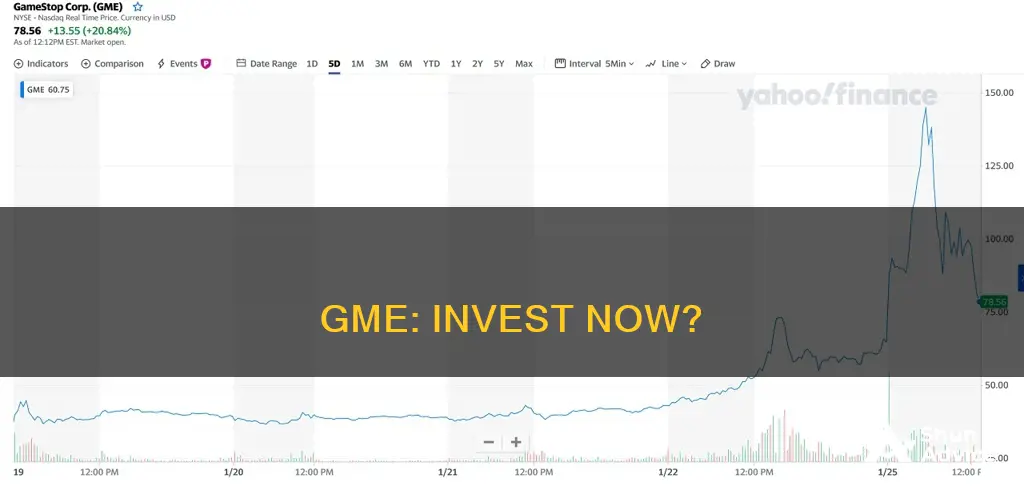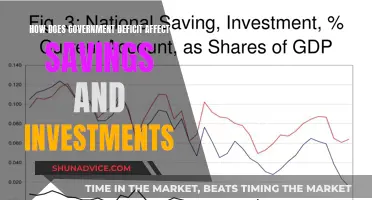
Investing in GameStop (GME) stock can be done in a few simple steps. First, you need to decide on a stock brokerage and sign up for an account. Then, you need to deposit money into your brokerage account. After that, you can search for and buy the GME stock, either at the current market price or using a limit order. Finally, you should regularly review your GME position to monitor the value of your investment. It's important to note that investing in the stock market comes with risks, and you should only invest money you can afford to lose.
What You'll Learn

Choosing a broker
The broker you choose will depend on your investment style and goals. There are two basic types of brokers: full-service brokers and discount brokers. Your choice should reflect your investment style—whether you lean towards active trading or a more passive, buy-and-hold approach.
- Fees and pricing: Be sure to understand the fee structure of the broker. Some common fees include per-trade commissions, annual or monthly account maintenance fees, deposit minimums, margin rates, and trading platform subscriptions.
- Reliability: Consider the broker's track record and reputation in the industry. Look for brokers that are regulated by state regulatory authorities, registered with the SEC, and members of organizations like the Financial Industry Regulatory Authority (FINRA) and the Securities Investor Protection Corporation (SIPC).
- Investment offerings: Ensure that the broker offers the types of investments you are interested in, such as individual stocks, options, mutual funds, exchange-traded funds (ETFs), and bonds.
- Execution quality: If execution price is important to you, research the broker's execution quality and their practices regarding payment for order flow.
- Tools and education: Look for brokers that offer educational resources, such as live webinars, how-to guides, video tutorials, and glossaries, especially if you are a new investor. Also, consider whether the broker provides tools like customizable watchlists, alerts, screeners, and advanced charting capabilities.
- Account minimums and fees: Some brokers require a minimum initial investment or account balance. Consider whether these requirements fit within your budget and investment goals. Be mindful of other account-related fees, such as transfer fees, withdrawal fees, and inactivity fees.
- Promotions: Online brokers often offer promotions or cash bonuses for new customers. While this shouldn't be the sole factor in your decision, it can be a tie-breaker between two similar options.
Some recommended brokers for buying GameStop (GME) shares include Interactive Brokers, eToro, Fidelity, Zacks Trade, and Charles Schwab. When choosing a broker, be sure to consider your specific needs and goals as an investor to make an informed decision.
Smart Ways to Invest Your $50
You may want to see also

Opening an account
To open an account to invest in GME, you will need to choose a broker. A broker is a financial services company that buys and sells shares of stock on your behalf, sometimes in exchange for an annual fee or commission.
There are dozens of brokers offering trading platforms and online accounts, and every broker located in the United States will allow you to buy and sell GameStop stock, as GME is currently listed on the New York Stock Exchange.
Some of the factors you might want to consider when selecting a broker include:
- Any fees the broker charges, either per-trade or annually
- The types of research offerings the broker provides
- The broker's platform (is it aimed at beginners or does it offer a range of charting tools for more advanced users?)
- Access to foreign markets and cryptocurrency markets, if you're interested in these
- The types of orders the broker supports
Once you have chosen your broker, opening your account typically involves registering your details, providing some information about your investment experience, and then identifying yourself by uploading a few official documents. All of this takes place online and can be completed fairly quickly. However, following your registration, most brokers need some additional time—from a few minutes to a couple of days—to confirm your account and allow you to start trading.
- Interactive Brokers: Extremely low fees, a wide range of products, and many great research tools.
- EToro: Free stock and ETF trading, seamless account opening, and social trading.
- Fidelity: Commission-free US stocks and ETFs, great trading platforms, and research.
- Zacks Trade: Low fees, an extensive stock and ETF selection, and great customer service.
- Charles Schwab: Free stock and ETF trading, outstanding research, and great customer service.
- Public: Easy to get started, multiple ways to fund your account, and a mobile app for iOS and Android.
Home Improvement: Who's Spending the Most?
You may want to see also

Depositing money
Once you've opened your brokerage account, you'll need to deposit money into it. The most common way to do this is by bank transfer, but many brokers also allow you to use a credit or debit card, or even an electronic wallet like PayPal. Deposits are typically free, and most brokers don't have a minimum deposit requirement.
After your account is funded, you can decide how many shares of GME you want to purchase. It's a good idea to look at the current market price of GME and the amount of money you want to invest. Remember that your investment can decrease in value at any time, so never invest more money than you can afford to lose. You may want to track the price of GME for a few days before investing to ensure you're buying at the most advantageous time.
Choosing Your Order Type
The type of order you choose will tell your broker when you want your order to be executed, the price you want to pay for each share, and more. Choosing the right kind of order gives you more control over its execution. Here are some of the most common order types:
- Limit Order: Tells your broker that you want to buy a stock but only if the order can be executed at or below a specific price. For example, you might set a limit order to buy GME stock at a maximum price of $195 per share.
- Market Order: Tells your broker that you want to buy the next available shares of the stock, regardless of the market price. Market orders give you less control over the price per share but are more likely to be filled than limit orders.
- Stop-Loss Order: Tells your broker that you want to sell your investment if its price falls to a certain level. For example, if you bought 10 shares of GME stock at an average price of $200 per share, you could set a stop-loss order at $196, which would automatically sell your shares if the price of GME fell to that level.
- Stop-Limit Order: Combines the characteristics of a limit order and a stop-loss order. You specify an upper limit price and a lower stop price. For example, if you set a limit price of $205 and a stop price of $195, your broker will fill the order as long as the stock can be purchased for $205 or less. If the price rises above $205, your broker will stop filling the order.
Wealth: Security, Freedom, and Legacy
You may want to see also

Researching the stock
Researching a stock is an essential step before making an investment. If your investments are not informed by a solid research process, you could be exposing yourself to unnecessary risks.
Researching the Industry
First, you need to understand the industry that the company operates in. This can be done by referring to the North American Industry Classification System (NAICS). This will allow you to find out basic industry information, such as its size, annual revenues, the number of companies in the industry, and its growth. You should also look for any regulatory issues that might be affecting the industry, such as trade agreements or government decisions. Finally, it's important to assess future trends in the industry, such as new products or types of products that might transform the industry in the coming years.
Understanding the Company
Next, you need to learn what the company does, how it makes money, and who its customers are. This information is often available on the "Investor Relations" section of a company's website, including an overview of the business, new developments, challenges, and results. You should also read expert commentary on the business from analysts and other experts, which can be found on sites like Stockchase.com, Yahoo Finance, and Google Finance. It's also important to inform yourself on the macroeconomic outlook for the business, as bigger economic forces could affect its performance. For example, a decline in coal prices due to reduced demand from China could negatively impact a coal company's stock price.
Performing Fundamental Analysis on the Business
Fundamental analysis refers to analyzing the financial information of a business to predict its future performance. This includes looking at the company's revenues over several years to determine if the business is growing, shrinking, or stagnant. You should also examine the company's gross profit margin, which is calculated by taking the company's revenues and subtracting the raw costs and labour used to make the goods sold. The higher the gross profit margin, the better.
Another important factor to consider is the company's debt. High levels of debt can be a bad sign, as it means the company has high interest expenses and may be unable to fund its growth. The debt-to-equity ratio can be used to determine how much debt a company has relative to its shareholder equity.
Analyzing the company's return on equity (ROE) will show what kind of profits a company is generating with its shareholders' money. ROEs above 10% are generally considered strong, but it's important to compare this metric to the company's peers.
Examining the company's earnings growth is also crucial, as high levels of earnings growth typically lead to high levels of share price growth. You can find past earnings growth on morningstar.com, and future growth estimates on Yahoo Finance.
Finally, you should determine the company's price-to-earnings ratio (P/E ratio), which helps to value a company by showing how much you are paying for a dollar of the company's profits. Generally, lower P/E ratios are preferable, as they indicate that you are getting a good deal for the stock.
Choosing a Broker
Once you have thoroughly researched the stock and decided that you want to invest in GME, you will need to choose a broker. Some factors to consider when selecting a broker include any fees they charge, the types of research offerings they provide, the platform they use, and the types of orders they support.
Placing Your Order
After choosing a broker and funding your account, you can decide how many shares of GME you would like to purchase. It's important to remember that your investment can decrease in value at any time, so you should never invest more money than you can afford to lose. You may want to track and monitor the changing price of GME for a few days before you invest to ensure that you're buying at the most advantageous time.
When you are ready to place your order, you will need to choose the type of order. A market order tells your broker that you want to buy the next available shares of the stock, regardless of the market price. A limit order, on the other hand, tells your broker that you want to buy a stock but only if the order can be executed at or below a specific price. There are also stop-loss orders, which tell your broker to liquidate your investment if the security falls to a certain price, helping to prevent excessive losses.
Hospitals: A Healthy Investment
You may want to see also

Making the trade
Once you've chosen your brokerage, you can proceed to make your trade. Here's a step-by-step guide:
Step 1: Open your brokerage account
Opening a broker account typically involves registering your details, providing information about your investment experience, and verifying your identity by uploading official documents. This process usually takes place online and can be completed quickly. However, after registration, most brokers need some additional time—from a few minutes to a couple of days—to confirm your account before you can start trading.
Step 2: Deposit money into your account
Before buying GameStop stocks, you need to deposit cash into your broker account. You can usually do this through a bank transfer, but many brokers also accept credit/debit card payments or even electronic wallets like PayPal. Deposits are typically free, and most brokers don't have a minimum deposit requirement.
Step 3: Find and buy GameStop shares
To buy GameStop shares, locate them within your broker's trading platform by searching for "GameStop" or its stock exchange symbol, "GME." Some brokers also allow you to search for stocks based on country or sector. If you use this method, remember that GameStop is a US Consumer Cyclical company known for selling video games, electronics, and accessories.
Once you've found GameStop, enter the number of shares you want to buy and click "buy." Many brokers also allow you to buy fractional shares, so you can invest a specific amount of money, such as $10, even if it's less than the price of a single share.
When placing your order, you can choose from different order types:
- A "market" buy order purchases the stock immediately at the current market price.
- A "limit" order allows you to specify the exact price you want to pay per share, and the order will only be executed if the stock reaches that price.
Step 4: Review your GameStop position regularly
After buying your GameStop shares, it's essential to monitor the value of your investment regularly. This will help you decide if you need to take any action, such as buying more shares or selling some to meet your investment goals.
If you're a short-term investor, you may use various order types to manage your holdings. For example, a "take-profit" order automatically sells your stock when it reaches a certain price to lock in profits, while a "stop-loss" order automatically sells your stock if its price falls to a certain level, limiting potential losses.
Where to Buy GME Stock
- Interactive Brokers: Known for extremely low fees, a wide range of products, and excellent research tools.
- EToro: Offers free stock and ETF trading, seamless account opening, and social trading features.
- Fidelity: Provides commission-free US stocks and ETFs, great trading platforms, and extensive research tools.
- Zacks Trade: Low fees, extensive stock and ETF selection, and outstanding customer service.
- Charles Schwab: Free stock and ETF trading, outstanding research, and great customer service.
Key Considerations
- Risk and Volatility: GameStop's stock has experienced extreme rallies and selloffs, and there's a risk that its value could crash quickly and without notice. It's important to carefully research and monitor the markets before investing.
- Short-Selling: GameStop's stock has been subject to short-selling in the past, and while investors can attempt another "short squeeze," exchanges might shut down these trades.
- Social Media Influence: The recent surge in GameStop's stock value has been influenced by coordinated efforts on social media and chat groups to buy the stock en masse. This phenomenon has been referred to as a "meme stock bubble."
People-Centric Investments: Key to Success
You may want to see also
Frequently asked questions
First, choose a stock brokerage platform and open a brokerage account. Then, deposit money into your account and decide how many shares you want to purchase. Finally, place a buy order.
GME can be a good investment if you do your research and monitor the markets carefully. Despite the decline in public interest in physical video games, video game sales remain steady.
GME stock may be riskier than other investments due to its history of inflated growth. The current surge in value has been fuelled by coordinated efforts from social media networks and chat groups to buy the stock en masse to profit from short sellers.
Consider factors such as fees, the types of research offerings, the platform's suitability for beginners or advanced users, access to foreign markets, and the types of orders supported.







